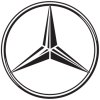
| Mercedes-Benz |
| Mercedes-Benz
Trucks |
| Mitsubishi-Fuso
trucks (Japan) - 89.29% |
| Freightliner
trucks (USA) |
| Aston Martin - 9.7% |
| MV Agusta
(Italy) - 25% |
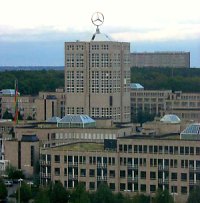 Headquarters:
Stuttgart
Headquarters:
StuttgartMain plants (passenger cars only):
Germany: Sindelfingen (C, E, CLS, S, CL-class, SLS, Maybach), Bremen (C, C coupe, E coupe, SLK, SL-class), Rastadt (old A and B-class)
Hungary: Kecskemet (new A and B class)
France: Hambach (Smart)
USA: Tuscaloosa, Allabama (ML, R, GL-class)
Brazil: Juiz de Forsa (CLC-class)
South Africa: East London (C-class)
Contract production in Austria: Magna Steyr at Graz (G-class)
Mercedes Cars sales (Mercedes + Smart + Maybach):
2023: 2,043,800 units
2022: 2,043,900 units
2021: 2,055,000 units
2017: 2,373,527 units
2016: 2,197,956 units
2015: 2,001,438 units
2014: 1,722,561 units
2013: 1,565,563 units
2012: 1,451,569 units
2011: 1,381,416 units
2010: 1,276,827 units
2009: 1,093,905 units
2008: 1,273,013 units
2007: 1,293,184 units
2006: 1,251,797 units
2005: 1,216,838 units
2017 sales by model:
A / B / CLA-class: 420,200 units (including GLA: 620,000 units)
C-class: 492,700 units
E / CLS-class: 398,200 units
S-class: 79,400 units
SUVs (GLA / GLC / GLE / GLS / G-class): 823,000 units
Sportscars (SLK / SL / GT): 25,000 units
Smart Fortwo / Forfour: 135,500 units
All AMG: 131,970 units
Even more confusing is that Daimler never marketed its cars under its own name, because Jaguar holds the rights of the Daimler name due to some historical reasons. Instead, Daimler always sells its cars as "Mercedes-Benz", which is totally irrelevant to the group name now.
Daimler or Mercedes-Benz, it is the oldest car maker in the world and has long been the benchmark of mass production premium cars. Its truck division is the largest in the world.
In 1885, Gottlieb Daimler and Karl Benz invented motorcycle and motor tricycle respectively. Daimler's motorcycle was rather simple, basically a wooden bicycle installed with his own petrol internal combustion motor. Benz's 3-wheeler appeared several months later but it included some advanced features, such as battery-powered ignition and differential, though it could barely reached 8 mph as the motor produced less than 1 hp. Next year, Daimler took one step further by putting his world-leading engine into a horse carriage, this became the first 4-wheel motor car in the world.
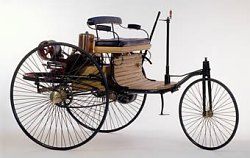 First motor tricycle by Karl Benz (1885)
First motor tricycle by Karl Benz (1885)Although their workshops located just 60 miles apart, the two German inventors were actually competitors. They founded their own companies, i.e., Benz and Daimler, and started producing cars separately. Following the death of Gotlieb Daimler in 1900, the Daimler name was sold to other companies, including a British company that eventually went under Jaguar (therefore Jaguar still owns the Daimler name today). Since then Daimler renamed its cars to "Mercedes", which was after the daughter of its sales director Emil Jellinek.
Entering the 20th Century, the pioneers started losing their leading edge. French maker Panhard Levassor and Peugeot pioneered many new concepts and technology. Ford started mass production in 1914. In contrast, Daimler and Benz were still making expensive cars in limited numbers. While the sales of Model T exceeded 1 million units in the mid-1920s, Daimler and Benz ran into financial crisis as Germany lost the first World War. This forced them to merge into Daimler-Benz in 1926. Since then its cars were branded as "Mercedes-Benz".
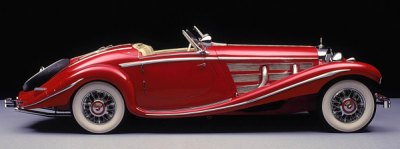 1936 Mercedes 540K
1936 Mercedes 540KMercedes-Benz still concentrated on producing high-end luxury and performance cars, but its pursuit of engineering excellence started winning admiration from all over the world. In the 1920s, Austrian Ferdinand Porsche served as its chief engineer and created the famous S / SS / SSK sports cars. This was followed by the elegant luxury grand tourers 500K and 540K in 1930s, which were perhaps the peak of all pre-war Mercedes. M-B cars were extensively used by German government officials and tycoons, becoming the symbol of German power. Adolf Hilter was also a loyal supporter of Mercedes-Benz.
After the second World War, Mercedes restarted production of its luxury cars which were based on the pre-war designs. However, the 300SL gullwing supercar shocked the world in 1950s with its advanced technology and motorsport victories. It established a high-tech image for the company. The C111 mid-engined concept car, powered by Wankel rotary engine, fuelled this image further in 1960s. Mercedes spent higher percentage of its income into R&D than other car makers. No wonder it pioneered a lot technologies in the following decades, such as crumple zones, anti-lock brakes, air bags and self-tightening seat belts.
 1955
Mercedes 300SL "Gullwing"
1955
Mercedes 300SL "Gullwing"In the mainstream production side, the post-war Mercedes adjusted its strategy to make premium cars for the mass market rather than only exclusive luxury cars. Two model lines were created - the mid-size W120 / W110 / W114 / W123 / W124 / E-class and the large-size W180 / W111 / W116 / W126 / W140 / S-class. Sales increased rapidly through the 60s and 70s and confirmed its status as the world's number one premium car maker. Meanwhile, it did not forget to produce some ultra luxury models for the richest and emperors, such as 600 Pullman.
In the early 1980s, Mercedes finally responded to BMW 3-Series and created its new entry level line, 190E (W201 series), which would evolve to C-class. In the late 1990s, A-class expanded its market coverage further into family hatch segment, while ML-class became its first road-going SUV. To stimulate sales, Stuttgart also derived its mainstream lines into many niche models, such as SLK, CLK, CLS, C-class Sports Coupe...
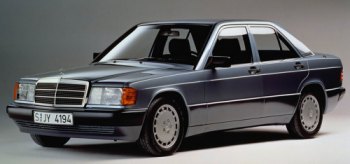 1982 Mercedes 190E (W201)
1982 Mercedes 190E (W201)There was a hard time in the early 90s. Strong Deustch Mark, high wages, the reunion of Germany and the recession in USA hit Mercedes hard. It had to change its "engineering first" philosophy and let accounting men to keep development budget tightly in control. The 1995 E-class saw a considerable downgrade in build quality and reliability. In the following decade, Mercedes was hampered by sliding image and massive recalls due to faulty electronics.
The management of Mercedes (or Daimler-Benz) made some more wrong decisions in 1990s. In 1994, they invested into a city car project originated by Swatch (Swiss watch maker), which would be known as Smart. The joint venture turned out to be a commercial failure. Swatch sold all its stakes to Mercedes. The latter tried to save it by expanding the Smart brand to a 3-model lineup (Fortwo, Roadster and Forfour), but the division continued making heavy loss. Eventually, Mercedes decided to leave only the Fortwo surviving and integrate Smart into its own operation.
 1998 Smart
1998 SmartAnother commercial failure was its acquisition of Chrysler in 1998. Daimler-Benz CEO Jurgen Schrempp wanted to forge an empire which would be the world's 5th largest car company. He claimed the merger was "made in heaven", but in reality it made little business sense because the high-end Mercedes cars and cheap Chrysler cars could be benefited little from cost sharing. As a result, Schrempp had to acquire 34% stakes in Mitsubsihi, bringing it into the new group to share platforms and components with Chrysler. Unfortunately, the Japanese company was also in finanicial trouble and became another burden to Daimler-Benz. The German did help improving Chrysler's cars and turned it back to black, but the good time did not last long. Chrysler ran into loss again in the mid-2000s. Eventually the German decided they had enough and sold off its American and Japanese partners.
The series of failed investment cost Mercedes a lot of money and stretched its R&D budget thin. As a result, it no long led the industry in build quality and technology. This gave BMW and Audi the chance to overtake it.